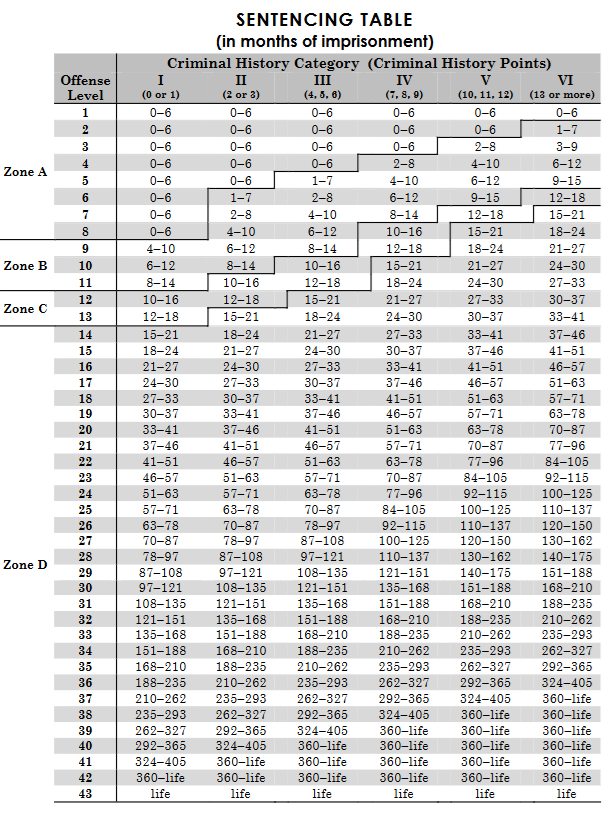What is Combs looking at if convicted?
Yes, it puts the cart before the proverbial horse, but no matter what, if he's convicted, it's going to be pretty bad
Sean "Diddy" Combs is charged in a federal superseding indictment with sex trafficking, transporting women for prostitution in violation of the Mann Act, and racketeering conspiracy under the RICO statute. The charges allege he used drugs, violence, and coercion over decades to exploit and control victims as part of a criminal enterprise.
I often get asked: “What’s he looking at if he gets convicted?” Well, he’s still a long way from getting convicted. But IF he is convicted, of even some of the crimes, the short answer is: he’s getting a lot of time. The long answer is a little more complicated.
In federal court, statutory maximums and minimums set the outer legal boundaries for a sentence, but they don’t determine the actual prison time imposed by the judge. Instead, judges rely on something called the U.S. Sentencing Guidelines, a complex formula, contained in a giant textbook, that calculates a recommended sentence based on the defendant’s conduct, something called “enhancements,” and his criminal history.
The “guidelines range”—a range of months—is calculated by (first) assigning a base offense level to the crime, then (second) adding or subtracting levels based on specific offense characteristics, victim impact, the defendant’s role, and other factors. Then (third) this total offense level (which is an arbitrary-looking number) is combined with the defendant’s criminal history category to produce a recommended sentencing range in months, using a handy X-Y chart that yields two numbers: a high and a low range, in months.
So if you have no criminal history and your offense level is a “21,” and you have no criminal history, your range is 37-46 months. But if you have the worst criminal history, then your range is 77-96 months. In sentencing, you want to be a “zero” when it comes to criminal history.
It gets even more complicated. The federal sentencing guidelines are no longer mandatory, after a 2005 Supreme Court ruling. That means judges must still go through the whole process of calculating the guidelines, but they consider them as advisory rather than binding. So that sentencing range? It might not be an indicator of what sentence you actually receive.
First, I don’t believe Combs has any criminal history. So that’s good. In 2001, he was acquitted of gun possession and bribery charges related to a nightclub shooting incident. But acquittals don’t count. So that makes it a little easier. But after that, it’s all bad for Combs if he’s convicted.
Will reasonable people disagree with my calculation? Absolutely. It’s hardly an exact science. Take a look at the government’s sentencing memorandum and the defendant’s sentencing memorandum in a given case. They will often disagree dramatically about the calculated guidelines range. So here’s my back-of-the-envelope estimate for Diddy if he’s convicted of, say, sex trafficking.
Combs’ Sex Trafficking count pursuant to 18 U.S.C. § 1591 is the only one with a “mandatory minimum” sentence. If convicted, no matter what the guidelines say, Combs must be sentenced to at least 15 years. That has nothing to do with the guidelines. Let’s see if the guidelines land him in a range close to 15 years (or 180 months).
First, the “base offense level” for 18 U.S.C. § 1591(b)(1), prohibited sexual conduct with someone other than a minor, is 34. That number sounds arbitrary because it is. A 34 is already pretty high in on the chart (look at the image above). But we’re not finished yet. Now we get into “Specific Offense Characteristics (SOCs)”. This is like a vicious pinball game, where the offender racks up additional levels for characteristics of the crime. Here are some potential SOCs that might apply to Combs, if and only if he’s convicted, and if there is evidence adduced of this conduct.
Use of Drugs to Facilitate Offense: +2 levels: Combs allegedly used drugs to coerce victims into sexual acts.
Offense Involved Multiple Victims: +2 levels could be added if multiple victims were involved over an extended period.
Use of Violence or Threats: +2 levels could be added if there’s evidence of physical assaults and threats were used to control victims. And so far, it sounds like there’s at least evidence of this.
Obstruction of Justice: +2 levels if there’s evidence of, say, attempted bribery and intimidation of witnesses. This can constitute obstruction.
Leadership Role in Criminal Activity: +4 levels. If he’s convicted, there seems to be little doubt the government will go for the leadership enhancement. It’s pretty much the theme of their indictment and the RICO charges: Combs allegedly led a criminal enterprise involving multiple participants.
So let’s see what we have so far: Total Offense Level: 34 (base) + 2 + 4 + 2 + 2 + 2 + 4 = 50.
Okay let’s assume a Criminal History category of I (no convictions). We go up to that chart above and…wait a minute. Uh oh. There’s no “50”.
That’s because the U.S. Sentencing Guidelines cap the offense level at 43. He’s maxed out. So, at offense level 43 and Criminal History Category I, the guideline range is life imprisonment. Plus, he has an automatic statutory mandatory minimum of 15 years. And that’s if he’s just convicted of sex trafficking. Because the guidelines are only advisory, the judge does not have to sentence him to life. But the judge must sentence him to at least 15 years if he’s convicted of sex trafficking.
Combs hasn’t been convicted of anything yet. In fact, while most federal crimes have a 95% conviction rate, I actually put Combs’ odds at closer to 80-85%. Still bad, but he has a few defenses and a great defense team. But if he’s convicted of anything, he’s going to learn what most criminal practitioners learn early on: federal court is not a fun place to be.




Just heard you on @Dean Obeidallah on SiriusXM PROGRESS channel 6/17/25